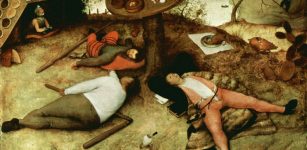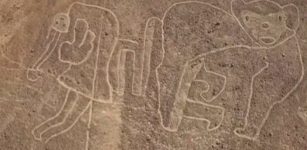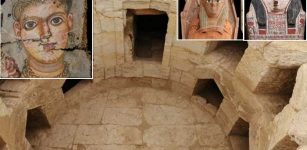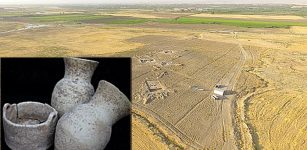Enigmatic Dispilio Tablet, Neolithic Flutes And The Traditional History Of Writing
A. Sutherland - AncientPages.com - This wooden tablet known as the Dispilio Tablet (or the Dispilio Disk), contradicts history as we know it.
If it is proved one day, the beginning of writing goes back at least two thousand years.
The curious wooden tablet was unearthed during the 1992 excavations conducted by the professor of prehistoric archaeology George Chourmouziadis and his team at the Aristotle University of Thessaloniki. The place of this fascinating discovery was the Neolithic settlement near the modern village of Dispilio on Lake Kastoria in Northern Greece.
The excavations yielded findings like bones, four different types of ceramic material were unearthed. These vessels were associated with food preparation (cooking utensils) and the offering and consumption of food.
Archaeologists also unearthed various artifacts, including ornamental items, figurines, decorative motifs adorning vessels, and certain specialized vessel types whose intended purpose remains elusive. Other finds included four objects composed of bone and clay, presumably utilized for producing sound (melody?)
Additionally, the team found a limited assemblage of funerary objects, as well as two additional child burials unearthed at an approximate depth of 80 centimeters and a collection of human bones.
As for the puzzling wooden tablet, it is covered with inscribed horizontal and vertical markings, some of which bear resemblance to the symbols of Linear A writing. This artifact is considered the most important find.
Do inscriptions on a wooden tablet represent the earliest communication effort in Southeastern Europe? Was it an early form of written speech of our ancestors?
The artifact - inscribed with symbols similar to those of the Vinca Culture - has been carbon 14-dated to about 5260 BC, which means that it is 2,000 years older than proto-Sumerian pictographic script from Uruk (modern Iraq) and 4,000 years older than the Cretan-Mycenean linear types of writing.
According to Professor Chourmouziadis, the text with the markings could not be quickly published because it would ultimately change the current historical background concerning the origins of writing and articulate speech depicted with letters instead of ideograms within the borders of the ancient Greek world and, by extension, the broader European one.
The current theory proposes that the ancient Greeks received their alphabet from the ancient civilizations of the Middle East (Babylonians, Sumerians, and Phoenicians). Thus, it fails to close the historic gap of some 4,000 years.
This gap translates into the following facts: while ancient eastern civilizations would use ideograms to express themselves, the ancient Greeks were similarly using syllables like we use today, according to Chourmouziadis.
The currently accepted theory suggests that the ancient Greeks learned to write around 800 BC from the Phoenicians.
Among the many important questions that emerge among scholars are:
The text of the Dispilio tablet. (Original text: c. 5300 BC). The marks on the tablet of Dispilio (column on the left) and similar signs in other ancient scriptures (remaining three columns). Image credit: Unknown author - Public Domain
- How can the Greek language have 800,000-word entries, ranking first among all known languages worldwide, while the second next has only 250,000-word entries?
- How could the Homeric Poems have been produced at about 800 BC, when the ancient Greeks first learned to write?
According to US linguistic research, the ancient Greeks could only have written these poetic works with a writing history dating back at least 10,000 years. Chourmouziadis, on the other hand, said that the markings on the tablet did not resemble the human figures, the sun and moon, or other figures ideograms usually depict.
Dispilio is the only excavated Neolithic lakeside settlement in Greece. Archaeological research showed that the site was continuously used from the Early Neolithic (about 6000 BC) to the Late Chalcolithic period (about 1200 BC, Mycenaean period).
Excavations revealed a portion of the settlement with the architectural layout of homes, the building materials, fragments of pottery, stone and bone tools, clay figurines (both anthropomorphic and zoomorphic), miniature representations of objects also on clay, animal and fish bones, and charred fruits and grains.
These findings contributed information on the everyday lives of the Neolithic inhabitants of the area. A series of charcoal and wood samples were radiocarbon dated to about 5470 to 4850 BC.
The most unexpected of the finds, a wooden tablet from the lake bearing engraved symbols, was 14 C dated to 5260 ± 40 BC. In addition, clay tablets and pottery vessels engraved with similar symbols were also unearthed from layers dated to the same period.
Written by – A. Sutherland - AncientPages.com Senior Staff Writer
First version of this article was published on Oct 28, 2014
Copyright © AncientPages.com All rights reserved. This material may not be published, broadcast, rewritten or redistributed in whole or part without the express written permission of AncientPages.com
Expand for referencesReferences:
Kokkinidou, Dimitra, and Katerina Trantalidou. “Neolithic and Bronze Age Settlement in Western Macedonia.” The Annual of the British School at Athens 86 (1991): 93–106.
IFANTIDIS, FOTIS. “Archaeographies: EXCAVATING NEOLITHIC DISPILIO.” In Archæographies: Excavating Neolithic Dispilio.
More From Ancient Pages
-
 Discovery Of Roman Settlement, Workshops And Artifacts Will Shed Light On Their Life In Northern England
Archaeology | Apr 13, 2017
Discovery Of Roman Settlement, Workshops And Artifacts Will Shed Light On Their Life In Northern England
Archaeology | Apr 13, 2017 -
 Medieval Paradise Cockaigne – Land Of Extreme Pleasure And Luxury
Featured Stories | Dec 12, 2018
Medieval Paradise Cockaigne – Land Of Extreme Pleasure And Luxury
Featured Stories | Dec 12, 2018 -
 Grandfather Frost And Snow Maiden Bring Gifts On New Year’s Eve
Christmas Traditions | Dec 31, 2024
Grandfather Frost And Snow Maiden Bring Gifts On New Year’s Eve
Christmas Traditions | Dec 31, 2024 -
 Mosaics With Oceanus And Medusa In Tomb Of Ancient City Of Perge, Turkey
Archaeology | May 16, 2017
Mosaics With Oceanus And Medusa In Tomb Of Ancient City Of Perge, Turkey
Archaeology | May 16, 2017 -
 Drones Discover 25 Never-Before-Seen Geoglyphs Near Famous Nazca Lines
Archaeology | Jun 4, 2018
Drones Discover 25 Never-Before-Seen Geoglyphs Near Famous Nazca Lines
Archaeology | Jun 4, 2018 -
 Clay Tablets Of Assyrian ‘King Of The World’ Esarhaddon Found Beneath Biblical Tomb Of Jonah
Archaeology | Mar 1, 2018
Clay Tablets Of Assyrian ‘King Of The World’ Esarhaddon Found Beneath Biblical Tomb Of Jonah
Archaeology | Mar 1, 2018 -
 Dragon Man: New Species Of Human May Replace Neanderthals As Our Closest Relative
Archaeology | Jun 26, 2021
Dragon Man: New Species Of Human May Replace Neanderthals As Our Closest Relative
Archaeology | Jun 26, 2021 -
 Unique Statue Of Warrior Wearing A Phrygian Cap Accidently Discovered By Dutch Fishermen
Archaeology | Aug 2, 2022
Unique Statue Of Warrior Wearing A Phrygian Cap Accidently Discovered By Dutch Fishermen
Archaeology | Aug 2, 2022 -
 Sir Francis Walsingham: Spymaster, Politician And Trusted Adviser To Queen Elizabeth I
Featured Stories | Nov 25, 2019
Sir Francis Walsingham: Spymaster, Politician And Trusted Adviser To Queen Elizabeth I
Featured Stories | Nov 25, 2019 -
 Amazing Margate Shell Grotto – Kent’s Greatest Mystery
Featured Stories | Jun 10, 2014
Amazing Margate Shell Grotto – Kent’s Greatest Mystery
Featured Stories | Jun 10, 2014 -
 31,000-Year-Old Skeleton Missing Foot May Show Oldest Amputation
Archaeology | Sep 7, 2022
31,000-Year-Old Skeleton Missing Foot May Show Oldest Amputation
Archaeology | Sep 7, 2022 -
 Marble Slab Production During Roman Imperial Time Was Much More Efficient Than It Is Today
Archaeology | May 14, 2021
Marble Slab Production During Roman Imperial Time Was Much More Efficient Than It Is Today
Archaeology | May 14, 2021 -
 Monumental Grave Of Ancient Greek Poet Aratus Located In Mersin- But It Cannot Be Opened
Archaeology | Jun 4, 2017
Monumental Grave Of Ancient Greek Poet Aratus Located In Mersin- But It Cannot Be Opened
Archaeology | Jun 4, 2017 -
 Secrets Of The Famous Hellenistic-Era Kyrenia Shipwreck Revealed
Archaeology | Jun 28, 2024
Secrets Of The Famous Hellenistic-Era Kyrenia Shipwreck Revealed
Archaeology | Jun 28, 2024 -
 European-Made Sealed Bottles Of Cherries Dated To 18th Century Found At Washington’s Mount Vernon
Archaeology | Apr 23, 2024
European-Made Sealed Bottles Of Cherries Dated To 18th Century Found At Washington’s Mount Vernon
Archaeology | Apr 23, 2024 -
 Huge Ptolemaic/Roman Funerary Structure Unearthed In Egypt’s Fayoum
Archaeology | Dec 6, 2022
Huge Ptolemaic/Roman Funerary Structure Unearthed In Egypt’s Fayoum
Archaeology | Dec 6, 2022 -
 Mesopotamian People Liked To Drink Beer Using Variety Of Drinking Vessels
Archaeology | Jun 28, 2018
Mesopotamian People Liked To Drink Beer Using Variety Of Drinking Vessels
Archaeology | Jun 28, 2018 -
 On This Day In History: Joan Of Arc Enters Orleans, The City Besieged By The English – On Apr 29, 1429
News | Apr 29, 2016
On This Day In History: Joan Of Arc Enters Orleans, The City Besieged By The English – On Apr 29, 1429
News | Apr 29, 2016 -
 Ancient Tools Found In Maryland Re-Write The History Of First Humans In America
Archaeology | May 29, 2024
Ancient Tools Found In Maryland Re-Write The History Of First Humans In America
Archaeology | May 29, 2024 -
 Humans May Be The Result Of An Evolution ‘Accident’- Scientists Say
Evolution | Sep 8, 2023
Humans May Be The Result Of An Evolution ‘Accident’- Scientists Say
Evolution | Sep 8, 2023



